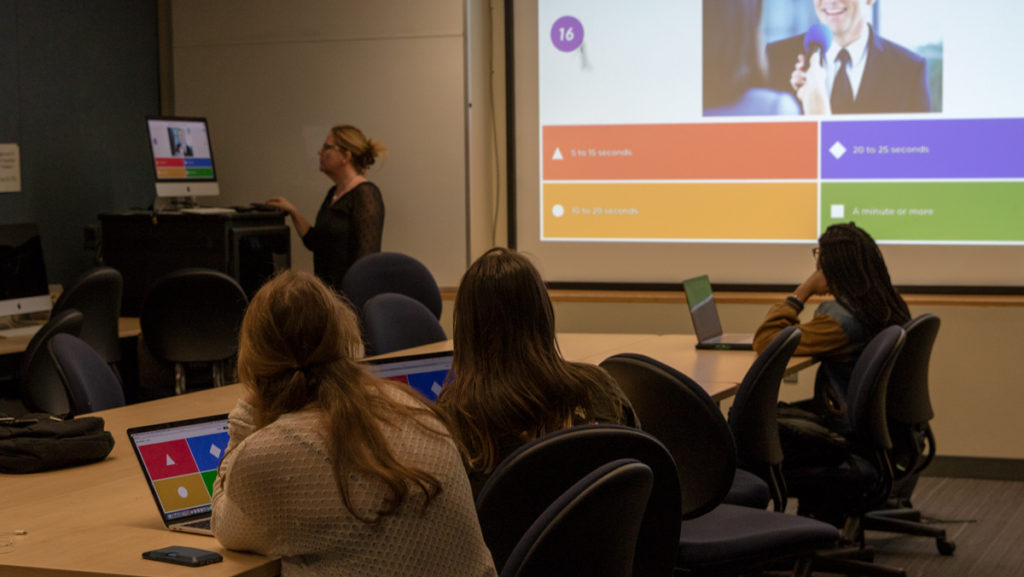As technology becomes more common in the classroom, faculty and students are entering a debate as to whether it hinders or benefits learning.
The debate about whether technology can be beneficial to a classroom learning environment or completely detract and distract from a professor’s lesson has been raging in higher education for quite some time. Ithaca College is also exploring this debate — many faculty members have varying opinions about technology in the classroom, and the college is also holding a survey in an attempt to better understand how faculty at the college use technology and also to compare the findings with feedback from faculty and students at other institutions.
Jim Rothenberg, associate professor in the Department of Sociology, said he does not allow any type of technology use in his classroom unless the laptop or other technology is being used appropriately.
“It has to be reasonable,” Rothenberg said. “It’s the abuse of it that’s the problem for me.”
Other professors, like Dan Breen, associate professor and chair of the Department of English, think that technology use should be monitored by the students themselves. He said that he does not require technology in the classroom but that he does allow technology use for note-taking and other assignments. He said that he knows when students are doing things other than taking notes but that if they misuse technology in the classroom it will be reflected in their grades.
“I’m not a babysitter,” Breen said. “They’re adults. I don’t really think it’s my job to walk around and wag my finger and punish them for decorum.”
Breen said technology is not necessarily helpful or unhelpful for his classes, which largely focus on examining literature.
“Technology is one of those things we tend to sort of consider a cure-all for things that happen in the classroom, but, really, it is just a tool,” Breen said. “There are some things that technology cannot accomplish. I don’t think technology is going to make people better readers. I don’t think it’s going to make people more adept to interpreting things or expressing themselves more clearly.”
The Faculty Council is also entering the debate. In February, the Faculty Council discussed the possibility of changing the current “opt–out” technology policy to an “opt–in” policy. This means that, currently, the college allows students to use technology like laptops in the classroom unless the professor explicitly states that this will not be allowed in their classroom. Changing the policy would mean technology would not be allowed in the classroom unless a professor explicitly states that it will be allowed in the classroom. The Faculty Council voted in support of changing the policy.
However, widespread policies that ban technology altogether can affect students who may depend on it more than others. Beyond the argument about whether technology can distract students from learning, the accessibility of technology in the classroom can also affect whether or not all students have equal opportunities to learn the material.
This issue is in part being explored in the EDUCAUSE Center for Analysis and Research (ECAR) survey that was released to the college community. The survey closed April 1. David Weil, associate vice president and chief information officer for Information Technology, said Information Technology partnered with EDUCAUSE, a nonprofit association aimed at advancing higher education through the use of IT, to release a survey on technology use in the classroom. ECAR provides data on higher–education trends and practices regarding technology.
Weil highlighted that instructor policies banning or discouraging mobile device use in the classroom could disproportionately affect students of color, students with disabilities, first-generation students, students who are independent and students who come from disadvantaged socioeconomic backgrounds.
“It’s things like that, that I think help inform the conversations on campus,” Weil said. “That’s why this is so valuable.”
The survey questioned both students and faculty on how often they use technology in the classroom as well as what kinds of technology are used. The findings for the survey have not yet been released. EDUCAUSE will share the college’s personal results and results from all colleges that participated in the survey with the college’s Information Technology staff. The results will be released publicly next fall.
Jenna Linskens, associate director of learning technologies in the Department of Teaching and Learning with Technology at the college, said that using technology in the classroom contributes to the universal design of learning — students come to college with a wide range of abilities, so some students may need to use technology, like screen readers, closed-captioning or applications that convert text to a simpler reading level, to address students who struggle with reading and to benefit their learning. However, she said it is important to acknowledge that there is a disparity between students who have the technology and those who do not because they cannot afford it. She said this is necessary to consider when making learning materials accessible to all students; while some may benefit from technology, some may be at a detriment because they do not have the same access.
Linskens said that at the college, online quizzes, like Kahoot and Top Hat, are often used in classrooms to ensure that students are understanding the content being presented. She also said many faculty members use Sakai, the college’s learning management system, where discussion questions, homework assignments, resources and quizzes can be posted. Some faculty members use LinkedIn Learning, a site that has video tutorials for a wide range of subjects, as supplemental materials to support the learning environments. VoiceThread is another tool that students can use in the classroom to provide responses to questions and presentations.
Linskens said it is difficult for students in college to break the habit of digital distraction if they have not been told from a young age when it is appropriate or not to use technology. However, many millennial and Generation Z students who attend college currently did not have this precedent set in their elementary school settings because technology in the classroom was not as prevalent then. She said that this is a skill and that classroom expectations should be set by the instructor so that students understand why a professor chooses to either include or not include technology in the classroom.
“I think it is possible for students to continue to engage in using technology in learning, but they have to become very disciplined in not responding to the immediate text,” Linskens said.
Allison Frisch, instructor in the Department of Journalism, said that she thinks technology is helpful in the classroom but that it is a challenge to make sure students are using technology exclusively for course material. She said her tactics regarding technology use change depending on the size of the class and how prone to distraction the students are. For instance, in one of her classes, she uses Kahoot, a game-based learning platform, but then requires laptops and phones to be put away afterward.

“If I know I have students who really can’t be distracted and I’m privy to that information about their learning approach and style and ability, then I try to make sure I keep it as distraction-free,” she said. “If we don’t need the screens or technology for what we’re doing in the learning environment, then I ask everybody to close them. It just helps us to keep a clean line between having it open for learning purposes and having it open for personal purposes.”
Sophomore Sierra Baker said she does not use technology in the classroom because she gets distracted during lessons and feels more organized having her notes written in one notebook. She said she often gets distracted by other students who are on their computers during class because they are usually on social media rather than taking notes.
“I think it’s kind of rude to have your laptop in class taking notes when you could just have it on paper,” Baker said. “In one of my classes where we don’t need technology, except for when our professors may be showing a video on the board, rarely ever do we use technology. Everyone has a laptop in the room on and they’re typing on it. I don’t know why because they don’t need to be taking notes on anything.”
However, she said her technology use changes from class to class. For instance, in her computer science class, she said that she uses laptops consistently because it is required for the coursework to code. She said she does not find that students are as distracted in that class because they are doing the work.
“Unless a computer is required for the course content, it’s really not necessary to have,” Baker said.
Freshman Madalyn Blomkvist said most of her classes have benefited from technology in the classroom. While some of her classes, like a graphic design class, rely directly on technology by requiring Photoshop, other classes, like a class for her Integrative Core Curriculum requirement, benefit from technology because students can use online resources instead of purchasing expensive textbooks. She said she does not see the benefit of banning technology from the classroom.
“Regardless of if a professor thinks technology is beneficial or not, everybody is going to be using it in the future,” she said. “Especially in communications and business, that’s what our future careers are going to revolve around. … It’s harmful to the students, I think, because it is so embedded in our society today and in the future, and professors need to realize that.”
Frisch said that in her classes for journalism, which is a field that is reliant on technology and multimedia, it is necessary to have technology. She said that in Fall 2019, she will create a working agreement with her students that outlines the boundaries of technology in the classroom.
“It becomes a conversation between the students and me about how we engage in the class,” she said.








